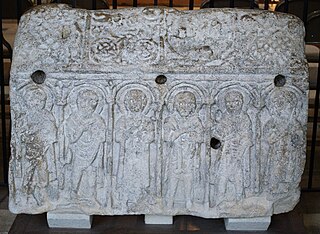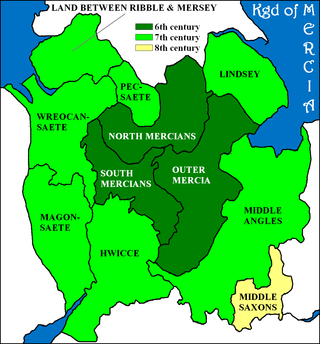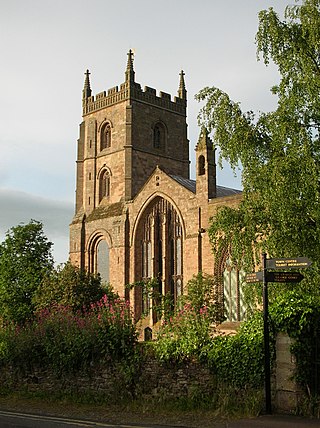
Thornton Abbey was a medieval abbey located close to the small North Lincolnshire village of Thornton Curtis, near Ulceby, and directly south of Hull on the other side of the Humber estuary. Its ruins are a Grade I listed building, including notably England's largest and most impressive surviving monastic gatehouse.

Anglo-Saxon architecture was a period in the history of architecture in England from the mid-5th century until the Norman Conquest of 1066. Anglo-Saxon secular buildings in Britain were generally simple, constructed mainly using timber with thatch for roofing. No universally accepted example survives above ground. Generally preferring not to settle within the old Roman cities, the Anglo-Saxons built small towns near their centres of agriculture, at fords in rivers or sited to serve as ports. In each town, a main hall was in the centre, provided with a central hearth.

Monk Bretton Priory is a ruined medieval priory located in the village of Lundwood, and close to Monk Bretton, South Yorkshire, England.
Lincolnshire, England derived from the merging of the territory of the ancient Kingdom of Lindsey with that controlled by the Danelaw borough Stamford. For some time the entire county was called 'Lindsey', and it is recorded as such in the Domesday Book. Later, Lindsey was applied to only the northern core, around Lincoln; it was defined as one of the three 'Parts of Lincolnshire', along with Holland in the south-east and Kesteven in the south west.

Nocton is a village and civil parish in the North Kesteven district of Lincolnshire, England. It is situated on the B1202 road, 7 miles (11 km) south-east from Lincoln city centre. The population of the civil parish at the 2011 census was 819. To the east of the village is Nocton Fen with its small settlement of Wasps Nest. To the west of the village, situated at the junction of Wellhead Lane and the B1188 road, is Nocton Top Cottages consisting of eight further dwellings. At the south of the village are the remains of Nocton Hall, and 1 mile (2 km) to the east the earthwork remains of Nocton Park Priory.

Partney is a small village and civil parish in the East Lindsey district of Lincolnshire, England. It is situated 3 miles (4.8 km) north of Spilsby, and in the Lincolnshire Wolds. The village was the birthplace of Henry Stubbe, the noted 17th-century Intellectual.

Medeshamstede was the name of Peterborough in the Anglo-Saxon period. It was the site of a monastery founded around the middle of the 7th century, which was an important feature in the kingdom of Mercia from the outset. Little is known of its founder and first abbot, Sexwulf, though he was himself an important figure, and later became bishop of Mercia. Medeshamstede soon acquired a string of daughter churches, and was a centre for an Anglo-Saxon sculptural style.

The Pecsætan, also called Peaklanders or Peakrills in modern English, were an Anglo-Saxon tribe who inhabited the central and northern parts of the Peak District area in England.

St Mary's Priory Church, Deerhurst, is the Church of England parish church of Deerhurst, Gloucestershire, England. Much of the church is Anglo-Saxon. It was built in the 8th century, when Deerhurst was part of the Anglo-Saxon kingdom of Mercia. It is contemporary with the Carolingian Renaissance on mainland Europe, which may have influenced it.

Leominster abbey was an Anglo-Saxon monastery established at Leominster in the county of Hereford, England. The name of the town refers to its minster, a settlement of clergy living a communal life.

Pentney is a village and civil parish in the English county of Norfolk, located about 8 miles (13 km) south east of King's Lynn placing it about halfway between King's Lynn and Swaffham on the A47 road. It covers an area of 10.39 km2 (4.01 sq mi) and had a population of 387 in 184 households at the 2001 census, increasing to 544 at the 2011 Census. For the purposes of local government, it falls within the district of King's Lynn and West Norfolk. It is in the valley of the River Nar, a tributary of the River Great Ouse.
Saint Eanswith, also spelled Eanswythe or Eanswide, was an Anglo-Saxon princess, who is said to have founded Folkestone Priory, one of the first Christian monastic communities for women in Britain. Her possible remains were the subject of research, published in 2020.

St Oswald's Priory was founded by Æthelflæd, daughter of Alfred the Great, and her husband Æthelred, ealdorman of Mercia, in the late 880s or the 890s. It appears to have been an exact copy of the Old Minster, Winchester It is a Grade I listed building.

Monks Kirby Priory was a Benedictine priory established in 1077 in Monks Kirby, Warwickshire, England. The priory was suppressed in 1415 when its estates and revenues were given to the Carthusian priory of Axholme in Lincolnshire, in whose possession they continued until the Reformation. Remains of the priory form part of Monks Kirby village church today.

The Abbey Church of Saint Peter and Saint Paul, Monkwearmouth–Jarrow, known simply as Monkwearmouth–Jarrow Abbey, was a Benedictine double monastery in the Kingdom of Northumbria, England.
Osburh was a Saint in Coventry, probably Anglo-Saxon but see below. Nothing about her life has survived to the present day. Her mortal remains were enshrined at Coventry. Close to the Forest of Arden, Coventry was at that time a tiny settlement.

Scremby is a village in the civil parish of Ashby with Scremby, in the East Lindsey district of Lincolnshire, England. It is situated about 4 miles (6.4 km) north-east from Spilsby. In 1971 the parish had a population of 57. On 1 April 1987 the parish was abolished and merged with Ashby by Partney to form "Ashby with Scremby".

Little Carlton is a village and civil parish in the East Lindsey district of Lincolnshire, England. It is situated approximately 6 miles (10 km) east from the town of Louth.
Dawn Marie Hadley is a British historian and archaeologist, who is best known for her research on the Anglo-Saxon and Viking Age periods, the study of childhood, and gender in medieval England. She is a member of the Centre for Medieval Studies and the department of archaeology at the University of York.















